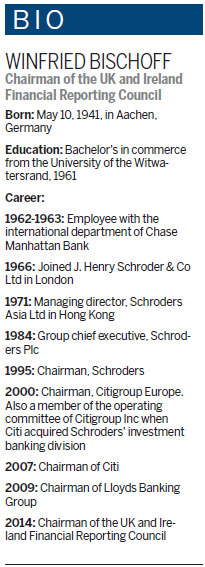No reason for angst on China's GDP
Updated: 2016-01-01 08:19
By Cecily Liu(China Daily Europe)
|
|||||||||
Former chairman of Lloyds Banking Group says even 6 percent growth would present few concerns
Winfried Bischoff has no concerns about China's slowing economic growth. He's done the math.
According to the former Lloyd's Banking Group chairman, recording a growth rate of just 6 percent this year would be the equivalent of recording 10 percent in 2008.
|
Winfried Bischoff says China will continue to do well in actual growth terms despite lower growth rates. Cecily Liu / China Daily |
"Who would have worried about 10 percent in 2008?" he asks.
Bischoff says his calculation is based on figures from a recent Standard & Poor's research article on China's contribution to global economic growth in 2014.
"People worry about China, but I don't worry," he says. "China will continue to do well in growth terms, although less in percentage terms. China is catching up with the United States, and we think 3 to 4 percent growth is fantastic for the US, so we have to get real about China's growth rate.
"China's greatest contribution to the world is to keep doing what it has been doing, which is to grow consumption."

In fact, he believes the country's ongoing contribution to global growth - in Asia, in particular - could have the same effect as when the United States launched its Marshall Plan in the late 1940s.
The plan, officially the European Recovery Program, saw the US give $13 billion - equal to about $90 billion in today's money - to help rebuild Western Europe after World War II. As a result, as these nations recovered their citizens were more able to buy American products.
"You cannot become rich on your own because unless your neighbors become rich you can't sell," Bischoff says. "The Marshall Plan helped Europe - with credit and loans. The US economy needed countries to be able to absorb the substantial production of which it was capable.
"My analogy is that, in order for China to continue to prosper, it may need to help some of its customer countries in two ways: Credit or, more directly, buying these countries' goods or raw materials. Growth in the domestic economy should enable both of these actions."
Bischoff, now chairman of the UK and Ireland Financial Reporting Council, an independent regulator aimed at fostering investment, has had a long career in London's financial services industry. Before taking the helm at Lloyds in 2009, he held top positions with Citigroup and Schroders.
Over his career, he has witnessed firsthand the rapid rise of China, which has increasingly become integrated in the global economy through its investments and the internationalization of its currency, the renminbi.
"There is a lot of currency, trade and investment flow into and from China," he says. "There is willingness among many global companies to start operations in China, and more Chinese companies have been going global, especially in the past three to four years. It's positive because the two-way trade is not just in goods."
In November, the International Monetary Fund decided to include the renminbi in its special drawing rights basket, which was hailed as a milestone in China's efforts to make the renminbi a major global reserve currency.
For Bischoff, the decision was significant because he feels it gives the renminbi an international status that reflects China's economic strength, and will help China's integration into the world financial systems. "The People's Bank of China (the central bank) has a great desire to make the renminbi a reserve currency, and it reflects China's economic strength and outward vision."
Chinese explorer Zheng He's expedition to Africa in the 15th century is an example of the country's outward-looking mind-set, he says, but since then China has largely focused inward. That is changing, though, as the economy becomes more international, he adds.
China has been seeking to rebalance its economy in recent years, moving away from relying on exports-driven manufacturing to high-value-added service sectors and domestic consumption.
Today's Top News
Inspectors to cover all of military
Britons embrace 'Super Thursday' elections
Campaign spreads Chinese cooking in the UK
Trump to aim all guns at Hillary Clinton
Labour set to take London after bitter campaign
Labour candidate favourite for London mayor
Fossil footprints bring dinosaurs to life
Buffett optimistic on China's economic transition
Hot Topics
Lunar probe , China growth forecasts, Emission rules get tougher, China seen through 'colored lens', International board,
Editor's Picks

|

|

|

|

|

|








